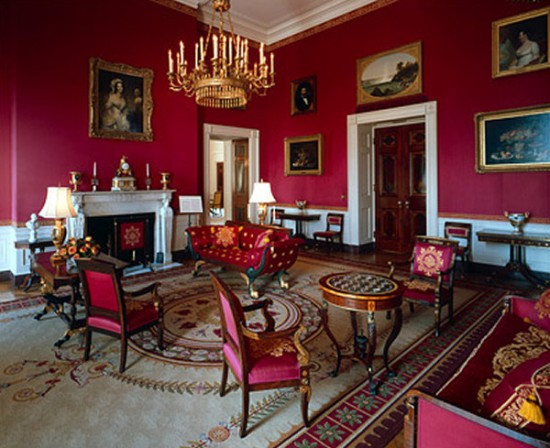- Home
- Learn About Antique Furniture and Reproductions
- Resources
- Reproduction Furniture Styles
- What is American Empire-Style Furniture?
What is American Empire-Style Furniture?
American Empire-style furniture is rich in neoclassical influence and historical symbolism, and masterfully balances restrained elegance with bold decorative flourishes. Hallmarks of the style include clawed feet, spiraled columns, intricate carvings, and motifs inspired by fauna, mythology, and maritime life. While many antique styles may appear similar at first glance, the American Empire era presents a distinct aesthetic narrative—one that reflects the aspirations, values, and creative ambitions of a burgeoning nation.
Origins and Influences
American Empire-style furniture traces its lineage to Empire-style furniture popularized during Napoleon Bonaparte’s reign in early 19th-century France. Though deeply rooted in French neoclassicism, the American interpretation evolved as a synthesis of French grandeur, British restraint, and the austerity of Greco-Roman design. This hybridization resulted in a style that was not merely imitative but uniquely American in spirit and symbolism.
The style gained widespread prominence in the United States around 1820, influencing not only furniture design but also architecture and visual arts. It marked a period when America—still young and defining itself—looked to the classical world for guidance while cultivating a voice of its own.
The Role of Key Artisans
Among the most celebrated figures in the American Empire movement is Duncan Phyfe (1768–1854), a Scottish-born cabinetmaker based in New York. Phyfe’s workshop became synonymous with refined neoclassical design, and his interpretation of the Empire aesthetic greatly shaped its trajectory in the United States. Another notable figure was Charles-Honoré Lannuier (1779–1819), a French émigré who brought direct influence from Paris to the New World. Both men sought to adapt European ideals into a new aesthetic language that resonated with American identity.
Their efforts quickly radiated beyond New York, reaching established furniture-making centers in Boston, Philadelphia, and Baltimore, each city contributing regional distinctions to the overall style.
Characteristics and Craftsmanship
Empire-style design in America initially emerged through cabinetmaking before expanding into a broader range of furniture forms. Key features include gilt-brass mounts, decorative inlays, and symmetrical compositions. Woodworkers favored dark, dense hardwoods—most notably mahogany—often adorned with classical motifs and polished to a high sheen.
Furniture from this era is often instantly recognizable by its carved animal feet, acanthus-leaf ornamentation, rope-twist details, and stylized columns. These components created an aesthetic that was as architectural as it was ornamental. Gilding, though used sparingly compared to its French counterpart, added a subtle yet luxurious glow to select elements.
The years between 1815 and 1825 represented the style’s most ornate phase. Elaborate decoration dominated, reflecting both the optimism of the post-war period and the artistic reach of American artisans. As the century progressed, these embellishments became more subdued, embodying a balance between expressive detail and national modesty.
Jeffersonian Influence
Thomas Jefferson (1743–1826), who returned from France with a new perspective on design, played a pivotal role in shaping the American iteration of the Empire style. Though he was exposed to French artistry during his ambassadorship, Jefferson gravitated toward a more restrained, neoclassical sensibility, advocating for the fusion of Roman and Greek asceticism with select European flourishes. His tastes influenced American preferences toward functionality, symbolism, and classical purity over opulence. This aesthetic choice reflected the values of a newly independent republic, favoring dignity over decadence, and integrity over indulgence.
National Identity and Design
By the mid-19th century, the American Empire-style furniture had become a vehicle for patriotic expression. Artisans deliberately incorporated symbolic carvings: eagles to convey nationalism, dolphins for harmony and protection, and lions for bravery and strength. Decorative elements such as cornucopias, garlands, and laurel wreaths referenced bounty and classical virtue.
This artistic language spoke volumes about America’s vision for itself: powerful, principled, and aspirational. While borrowing from European precedents, American Empire furniture intentionally distinguished itself through cultural pride and democratic values.
A Living Legacy: The White House Red Room
Perhaps the most iconic representation of American Empire furniture is found in the Red Room of the White House. Decorated most famously by Jacqueline Kennedy (1929–1994), the room features richly carved mahogany furnishings, gilt-bronze accents, and historic textiles. The decor draws inspiration directly from French Empire models, yet reinterprets them with American craftsmanship and materials.
Animal-themed carvings—lions, dolphins, sphinxes—embellish furniture in the room, echoing national symbolism. The thirty-six-light French Empire chandelier, dating to circa 1805, remains a central visual anchor. The Red Room’s textiles, wall coverings, and carpet—woven in the U.S. but modeled on 19th-century French designs—reinforce the dialogue between transatlantic influence and American interpretation.
Enduring Appeal and Symbolism
Defining characteristics of American Empire furniture include:
- Clean lines and structured forms
- Dark, robust woods (particularly mahogany)
- Minimalist upholstery, often in monotone fabrics
- Symbolic carvings rooted in animal and mythological motifs
While heavily inspired by European traditions, American Empire furniture captures the spirit of early American identity—a blend of ambition, humility, and national pride. It tells a story not only of artistic evolution but of a country's search for a visual language of its own.
From the richly adorned parlors of 19th-century mansions to presidential drawing rooms, these pieces continue to exude a quiet authority and timeless charm. Even centuries later, American Empire-style furniture serves as a material link to the foundational ideals of the United States—fortitude, refinement, and the pursuit of enduring beauty.









